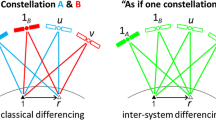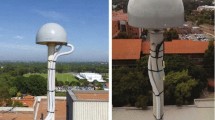Abstract
The Indian Regional Navigation Satellite System (IRNSS), which is being developed for positioning services in and around India, is the latest addition to the global family of satellite-based navigation systems. As IRNSS only shares the L5-frequency with GPS, the European Galileo, and the Japanese Quasi-Zenith Satellite System (QZSS), it has at least at present a limited interoperability with the existing systems. Noting that the L5-frequency capability is under development even for GPS, this contribution assesses the interoperability of the IRNSS L5-signal with the GPS, Galileo, and QZSS L5/E5a-signals for positioning and navigation using real data collected in Perth, Australia. First, the noise characteristic of the IRNSS L5-signal and its comparison with that of the GPS, Galileo, and QZSS L1/E1- and L5/E5a-signals is presented. Then, the L5-observables of combined systems (formed from IRNSS, GPS, Galileo, and QZSS) are assessed for real-time kinematic positioning using the standard LAMBDA method and for instantaneous attitude determination using the constrained LAMBDA method. The results show that the IRNSS L5-signal has comparable noise characteristics as that of the other L5/E5a-signals. For single-frequency carrier phase-based positioning and navigation, the results show better ambiguity resolution performance of L5/E5a-only processing than that of L1/E1-only processing.










Similar content being viewed by others
References
de Bakker PF, Tiberius CCJM, van der Marel H, van Bree RJP (2012) Short and zero baseline analysis of GPS L1 C/A, L5Q, GIOVE E1B, and E5aQ signals. GPS Solut 16:53–64
EU (2010) European GNSS (Galileo) open service: signal in space interface control document, Issue 1, Revision 1, European Union, Sep 2010
Euler H-J, Goad C (1991) On optimal filtering of GPS dual frequency observations without using orbit information. J Geod 65:130–143
GPSD (2013) Navstar GPS space segment/navigation user segment interfaces, Revision F (IS-GPS-200H:24-Sep-2013), global positioning system directorate
ISRO (2014). Indian regional navigation satellite system: signal in space ICD for standard positioning service, Version 1.0, ISRO Satellite Centre, Jun 2014
Javad (2014) Javad Delta multi-GNSS receiver. Personal communication, Dec 2014
JAXA (2012) Interface specification for QZSS, Japan Aerospace Exploration Agency
Langley RB (2014) ESA discusses Galileo satellite power loss, upcoming launch. http://gpsworld.com/esa-discusses-galileo-satellite-power-loss-upcoming-launch/, Aug 2014. Online; accessed: 06 Jan 2015
Montenbruck O, Steigenberger P, Khachikyan R, Weber R, Langley R, Mervart L, and Hugentobler U (2013) IGS-MGEX: preparing the ground for multi-constellation GNSS science, proceedings 4th international colloquium scientific and fundamental aspects of the galileo programme, Prague, Czech Republic, 4–6 Dec 2013, ESA-European GNSS Agency, pp 1–8
Nadarajah N, Teunissen PJG (2014) Instantaneous GPS/Galileo/QZSS/SBAS attitude determination: a single-frequency (L1/E1) robustness analysis under constrained environments. Navigation 61(1):65–75
Nadarajah N, Teunissen PJG, Raziq N (2013) Instantaneous GPS–Galileo attitude determination: single-frequency performance in satellite-deprived environments. IEEE Trans Veh Technol 62(7):2963–2976
Nadarajah N, Teunissen PJG, Sleewaegen J-M, Montenbruck O (2014a) The mixed-receiver BeiDou inter-satellite-type bias and its impact on RTK positioning. GPS Solut. doi:10.1007/s10291-014-0392-6
Nadarajah N, Teunissen PJG, Raziq N (2014b) Instantaneous BeiDou–GPS attitude determination: a performance analysis. Adv Space Res 54(5):851–862
Odijk D, Teunissen PJG (2013) Characterization of between-receiver GPS-Galileo inter-system biases and their effect on mixed ambiguity resolution. GPS Solut 17(4):521–533
Odijk D, Teunissen PJG, Huisman L (2012) First results of mixed GPS + GIOVE single-frequency RTK in Australia. J Spat Sci 57(1):3–18
Rao VG (2013) Proposed LOS fast TTFF signal design for IRNSS, PhD thesis, University of Calgary
Rethika T, Mishra S, Nirmala S, Rathnakara SC, Ganeshan AS (2013) Single frequency ionospheric error correction using coefficients generated from regional ionospheric data for IRNSS. Indian J Radio Space Phys 42(3):125–130
Sekar S, Sengupta S, and Bandyopadhyay K (2012) Spectral compatibility of BOC(5,2) modulation with existing GNSS signals, PLANS-2012 IEEE/ION, Myrtle Beach, SC, Apr 2012, pp 886–890
Takasu T (2007) RTKLIB: An open source program package for GNSS positioning, available online: www.rtklib.com
Tegedor J, Øvstedal O (2014) Triple carrier precise point positioning (PPP) using GPS L5. Surv Rev 46(337):288–297
Teunissen PJG (1995) The least-squares ambiguity decorrelation adjustment: a method for fast GPS integer ambiguity estimation. J Geod 70:65–82
Teunissen PJG (2006) The LAMBDA method for the GNSS compass. Artif Satell 41(3):89–103
Teunissen PJG (2010) Integer least-squares theory for the GNSS compass. J Geod 84(7):433–447
Teunissen PJG, Amiri-Simkooei A (2008) Least-squares variance component estimation. J Geod 82:65–82
Thoelert S, Montenbruck O, Meurer M (2014) IRNSS-1a: signal and clock characterization of the Indian regional navigation system. GPS Solut 18(1):147–152
Acknowledgments
This work has been executed as part of the Positioning Program Project 1.01 “New carrier phase processing strategies for achieving precise and reliable multi-satellite, multi-frequency GNSS/RNSS positioning in Australia” of the Cooperative Research Centre for Spatial Information (CRC-SI). The third author P. J. G. Teunissen is the recipient of an Australian Research Council Federation Fellowship (Project Number FF0883188). A development version of firmware for JAVAD receivers was kindly provided by JAVAD GNSS Inc. All this support is gratefully acknowledged.
Author information
Authors and Affiliations
Corresponding author
Rights and permissions
About this article
Cite this article
Nadarajah, N., Khodabandeh, A. & Teunissen, P.J.G. Assessing the IRNSS L5-signal in combination with GPS, Galileo, and QZSS L5/E5a-signals for positioning and navigation. GPS Solut 20, 289–297 (2016). https://doi.org/10.1007/s10291-015-0450-8
Received:
Accepted:
Published:
Issue Date:
DOI: https://doi.org/10.1007/s10291-015-0450-8




